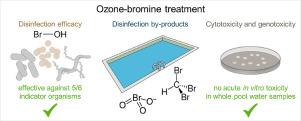Water Research ( IF 12.8 ) Pub Date : 2021-09-09 , DOI: 10.1016/j.watres.2021.117648 Fatima El-Athman 1 , Lisa Zehlike 1 , Alexander Kämpfe 2 , Ralf Junek 3 , Hans-Christoph Selinka 4 , Daniel Mahringer 1 , Andreas Grunert 1

|
Pool water is continuously circulated and reused after an extensive treatment including disinfection by chlorination, ozonation or UV treatment. In Germany, these methods are regulated by DIN standard 19643. Recently, the DIN standard has been extended by a new disinfection method using hypobromous acid as disinfectant formed by introducing ozone into water with naturally or artificially high bromide content during water treatment.
In this study, we tested the disinfection efficacy of the ozone-bromine treatment in comparison to hypochlorous acid in a flow-through test rig using the bacterial indicator strains Escherichia coli, Enterococcus faecium, Pseudomonas aeruginosa, and Staphylococcus aureus and the viral indicators phage MS2 and phage PRD1. Furthermore, the formation of disinfection by-products and their potential toxic effects were investigated in eight pool water samples using different disinfection methods including the ozone-bromine treatment. Our results show that the efficacy of hypobromous acid, depending on its concentration and the tested organism, is comparable to that of hypochlorous acid. Hypobromous acid was effective against five of six tested indicator organisms. However, using Pseudomonas aeruginosa and drinking water as test water, both tested disinfectants (0.6 mg L−1 as Cl2 hypobromous acid as well as 0.3 mg L−1 as Cl2 hypochlorous acid) did not achieve a reduction of four log10 levels within 30 s, as required by DIN 19643.
The formation of brominated disinfection by-products depends primarily on the bromide concentration of the filling water, with the treatment method having a smaller effect. The eight pool water samples did not show critical values in vitro for acute cytotoxicity or genotoxicity in the applied assays. In real pool water samples, the acute toxicological potential was not higher than for conventional disinfection methods. However, for a final assessment of toxicity, all single substance toxicities of known DBPs present in pool water treated by the ozone-bromine treatment have to be analyzed additionally.
中文翻译:

臭氧-溴处理池水消毒:评估消毒效果以及溴化消毒副产物的发生和体外毒性
泳池水经过广泛的处理,包括通过氯化、臭氧或紫外线处理进行消毒后,会不断循环和重复使用。在德国,这些方法受 DIN 标准 19643 的约束。最近,DIN 标准又扩展了一种新的消毒方法,使用次溴酸作为消毒剂,在水处理过程中将臭氧引入自然或人为地含有高溴化物的水中。
在这项研究中,我们使用细菌指示菌株大肠杆菌、屎肠球菌、铜绿假单胞菌和金黄色葡萄球菌以及病毒指示菌噬菌体 MS2 ,在流通式试验台中测试了臭氧-溴处理与次氯酸相比的消毒效果和噬菌体 PRD1。此外,使用不同的消毒方法(包括臭氧 - 溴处理)在 8 个泳池水样中研究了消毒副产物的形成及其潜在的毒性作用。我们的结果表明,次溴酸的功效(取决于其浓度和测试的生物体)与次氯酸的功效相当。次溴酸对六种测试指示生物中的五种有效。但是,使用铜绿假单胞菌和饮用水作为测试水,两种测试的消毒剂(0.6 mg L -1作为 Cl 2次溴酸以及 0.3 mg L -1作为 Cl 2次氯酸)在 30 秒内没有实现四个 log 10水平的降低, 符合 DIN 19643 的要求。
溴化消毒副产物的形成主要取决于灌水的溴化物浓度,处理方法影响较小。在应用的测定中,八个池水样品在体外没有显示出急性细胞毒性或基因毒性的临界值。在实际池水样品中,急性毒理学潜力并不高于常规消毒方法。然而,对于毒性的最终评估,必须另外分析存在于经臭氧-溴处理的池水中的已知 DBP 的所有单一物质毒性。



























 京公网安备 11010802027423号
京公网安备 11010802027423号